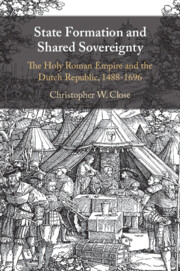Book contents
- State Formation and Shared Sovereignty
- State Formation and Shared Sovereignty
- Copyright page
- Contents
- Maps
- Acknowledgments
- Abbreviations
- Maps
- Introduction
- 1 The Swabian League and the Politics of Alliance (1488–1534)
- 2 Alliances and the Early Reformation (1526–1545)
- 3 Alliances and New Visions for the Empire and the Low Countries (1540–1556)
- 4 Shared Sovereignty and Regional Peace (1552–1567)
- 5 Shared Sovereignty and Multi-confessionality in the Empire and the Low Countries (1566–1609)
- 6 Religious Alliance and the Legacy of Past Leagues (1591–1613)
- 7 Religious Alliance and the Thirty Years’ War (1610–1632)
- 8 Westphalia and Politics of Alliance in the Empire and the Dutch Republic (1631–1696)
- Conclusion
- Bibliography
- Index
3 - Alliances and New Visions for the Empire and the Low Countries (1540–1556)
Published online by Cambridge University Press: 02 March 2021
- State Formation and Shared Sovereignty
- State Formation and Shared Sovereignty
- Copyright page
- Contents
- Maps
- Acknowledgments
- Abbreviations
- Maps
- Introduction
- 1 The Swabian League and the Politics of Alliance (1488–1534)
- 2 Alliances and the Early Reformation (1526–1545)
- 3 Alliances and New Visions for the Empire and the Low Countries (1540–1556)
- 4 Shared Sovereignty and Regional Peace (1552–1567)
- 5 Shared Sovereignty and Multi-confessionality in the Empire and the Low Countries (1566–1609)
- 6 Religious Alliance and the Legacy of Past Leagues (1591–1613)
- 7 Religious Alliance and the Thirty Years’ War (1610–1632)
- 8 Westphalia and Politics of Alliance in the Empire and the Dutch Republic (1631–1696)
- Conclusion
- Bibliography
- Index
Summary
Chapter 3 explores the aftermath of the Braunschweig-Wolfenbüttel invasion for both the Empire and the Low Countries. The 1540s and 1550s witnessed significant upheaval that encouraged multiple plans for corporate alliance, including an effort to restructure the Empire and the Low Countries into a massive Imperial League headed by Emperor Charles V. During this era, the politics of alliance became tied to a growing conviction among Catholic and Protestant Estates that the Empire’s well-being depended on the preservation of one’s own religious confession. These developments had major implications for the Low Countries, as Charles’s failure to create the Imperial League led to a redefinition of the relationship between the Habsburg Netherlands and the Empire in the 1548 Burgundian Transaction. Ultimately, the aftermath of the Schmalkaldic League’s military defeat, coupled with the shared desire of Protestants and Catholics to use alliances to preserve peace and their respective religious faiths, created the context for the 1555 Religious Peace of Augsburg. This agreement, in turn, set the parameters for corporate leagues for decades to come.
Keywords
- Type
- Chapter
- Information
- State Formation and Shared SovereigntyThe Holy Roman Empire and the Dutch Republic, 1488–1690, pp. 96 - 134Publisher: Cambridge University PressPrint publication year: 2021

